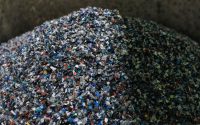In County Donegal, Ireland, a Tiny Inn Offers a Hyper-Local Travel Experience
The back story of Breac House, a tiny hotel in northwest Ireland’s County Donegal, sounds like a cautionary tale: Two city-slickers, accountants from Dublin, who’d never worked at a hotel or served a scone, decide to open a custom-built, designer property on a remote, windswept peninsula that juts out into the Atlantic Ocean. Cue the wizened locals ready to fleece them, the natural and man-made catastrophes, and you have all the makings of a bad sitcom, with Monocle meets Fawlty Towers as the log line.
The reality is different: Cathrine Burke, 51, and Niall Campbell, 51, have managed to create a remarkable hotel, not by flying in a starchitect from London, stocking the place with fancy products and serving globalized cuisine, but by staying resolutely Donegal. Their guiding principle in selecting materials, products, craftspeople and foodstuffs has been “from Donegal, when it’s the best.”
Underpinning the success of their four-room hotel, which is already full for their 2023 season and quickly filling up for next year, are the local chefs, chandlers, farmers, designers, weavers, potters and soapmakers they work with.
In a place known as Ireland’s “forgotten county” — largely because of its position in the far northwest of the Republic of Ireland, next to Northern Ireland and far from tourist draws like Dublin or Galway — there’s a flourishing and robust ecosystem of great contemporary food, design and craft just starting to become known to the rest of this island nation and to the world. The people behind this are young and old, longtime residents and newcomers, business neophytes and seasoned entrepreneurs.
Take Bernie Murphy, a fashion designer who spent over 20 years working for a local Fruit of the Loom factory, lost her job then struck out on her own, launching collections that have landed her high praise from influential fashion critics. Or Isobel Sangha, a bioengineer who moved home after years in Dublin, and launched the Donegal Natural Soap Company, which incorporates foraged Donegal materials, originally as a way to aid her son, who had infant eczema. Hannah McGuiness is a designer who makes striking and colorful jewelry while also running a design collective and store called Donegal Designer Makers. And then there’s Ciaran Sweeney, a chef from Downings who enjoyed great success in Dublin, then came back home to cook at the Olde Glen Bar, sharing with diners some of his culinary memories from a childhood spent here, next to the sea, with a fisherman grandfather.
Though they are a diverse bunch, there are some common forces at work. Ireland has lurched from boom to bust and back again over the past 30 years. “There’s nothing like a recession to focus the mind,” said Mr. Campbell of Breac House. “It makes people think ‘If I really want to do this, I need to do it right now.’”
Natural inspiration
There is also the inspiration of the land, with its craggy coastlines, broad sandy beaches, gray stone mountains and colorful wildflowers, moss and seaweed. From Breac House’s hillside vista nearly all these elements are visible: To the far left is Dunfanaghy’s Killahoey Beach, which leads to a saltwater inlet that, at low tide, is crossed by horseback riders. Tracking right, after the town center, a small stone bridge connects Breac’s landmass, the Horn Head Peninsula, to the mainland. Finally, all the way southwest, steep dunes lead to Tramore Beach, accessible only by a mile-long hike. The colors and contrasts of the landscape are the obvious inspiration for the region’s most famous product, Donegal tweed.
“What’s distinctive about our tweed is that a more neutral base color is decorated with small flecks of bright colors,” said Kieran Molloy, 37, who, along with his father, runs Molloy & Sons, a tweed-maker in Ardara. “Traditionally these bright colors were made from natural dyes that came from flowers, moss, seaweed and berries that were found here.”
Mr. Molloy studied industrial design in Dublin at the National College of Art and Design, one of the country’s most prestigious design schools, worked in the big city, then lost his job in 2009, when the recession hit hard. His mother had always threatened, “If you don’t go to college, you’ll be stuck out in the shed, weaving like your father.” And, indeed, Mr. Molloy, though college-educated, found himself home anyway and stuck out in the shed. So he and his father joined forces, spun off their own business from the larger family enterprise, and created tweeds that are lighter, brighter and made for today’s consumers, not designed for an era before central heating. They now export their fabric all over the world.
Tony Davidson, 38, worked as a chef in fine restaurants in Belfast for four years. He and his Swedish partner, Lina Reppert, 36, who managed restaurants in Belfast, always dreamed of opening a small place of their own in Donegal. On a visit to Mr. Davidson’s family’s vacation home here a few years ago, they saw a tiny building, part of a pub, that was empty and had a great view of the horseshoe-shaped beach at Downings. After Tony hosted a successful seafood pop-up there, he convinced the owner to rent them the space.
When they opened Fisk Seafood Bar, a local friend said to Mr. Davidson, “You’re only selling fish? Are you out of your mind?” He didn’t mean it as a joke. For years Ireland sent most of its best seafood abroad.
But with places like Fisk cooking direct, delicious, creative food using Donegal’s bounty, all that is starting to change. “We have some of the best crabs in Europe just down the road,” said Mr. Davidson. “We have a guy who dives for amazing scallops and collects them by hand. We have great mussels, oysters and all kinds of fish. People abroad have been buying our products for years, but locals are just starting to rediscover what’s right here, all around them.”
Local touches
Breac House is a kind of living museum of this kind of local food, craft and design. They’ve hosted pop-ups helmed by Mr. Sweeney, Mr. Davidson and other Irish chefs. Their soap comes from Isobel Sangha’s company. Their tweed blankets and couch coverings are handwoven by Eddie Dougherty, one of the last hand-weavers of tweed left in the region — and the world.
Beyond these more obvious local touches, there are also subtle design choices almost impossible to perceive by visitors, but important to Ms. Burke and Mr. Campbell, who live on the premises. Though one facade of their building is thoroughly modern, the proportions of their doors and windows on the entry side are based on a historical longhouse design. Their two-person, wood-fired sauna, which appears modern, sleek and Scandinavian, shares all the defining elements of a traditional Irish sweathouse: a window with a view of the land, a living grass roof and a dark interior.
Though all four guest rooms at Breac House share a subtle and attractive aesthetic, with tan wood, clean lines and comfortable furnishings, it’s the expansive bay, mountain and farmland views from the hillside perch, framed by floor-to-ceiling windows, that dominate the design. There is a small, wooden bench at the window, from which to sit and gaze outside, as well as a terrace attached to each room. (Rooms rent for 355 euros a night, or about $389, breakfast included.) A special two-way compartment allows breakfast to be delivered without opening the door.
These details point to something significant about Breac House: Unlike most businesses the world over, Ms. Burke and Mr. Campbell didn’t design the hotel with a particular demographic or ideal customer in mind. They said they simply built what they thought would be great, and let the customers come if they would.
Mr. Campbell’s hand-drawn map guided me around the peninsula on my morning runs and afternoon bike rides. Ms. Burke’s homemade breakfasts, which include bread she bakes, yogurt she ferments, honey she buys from a beekeeper across the way, and goose eggs from a farmer down the road, are her personal ideal of what guests ought to eat.
During pandemic-induced downtime, Mr. Campbell and Ms. Burke added a fourth room to the hotel, which they believe is the biggest they can become while still staying true to their ideal of a hotel run completely hands-on, by them. They have also added multiday chef-driven experiences to replace the one-night pop-up dinners they previously hosted. Breac House visitors can now meet guest chefs not just for a few words after dinner, but over the course of three days, visiting nearby farms together, eating meals and sharing drinks. (The cost for two nights lodging and breakfast, as well as two dinners and excursions, is 2,950 euros for two.)
One dinner I had, cooked by the chef Cuan Greene, 30, who worked at Noma and was later head chef at a renowned Dublin restaurant, Bastable, focused on local products like oysters, turbot, ramson and rhubarb.
Breac House’s success, so evident at this meal, presents a perhaps unsolvable dilemma: How to provide this level of engagement and intimacy to the many more guests who want it, without compromising the essence of what a place like Breac House has created.
But, said Mr. Campbell, “After two years of Covid shutdowns and interruptions, there are much worse problems we can imagine.”
Follow New York Times Travel on Instagram and sign up for our weekly Travel Dispatch newsletter to get expert tips on traveling smarter and inspiration for your next vacation. Dreaming up a future getaway or just armchair traveling? Check out our 52 Places to Go in 2023.


